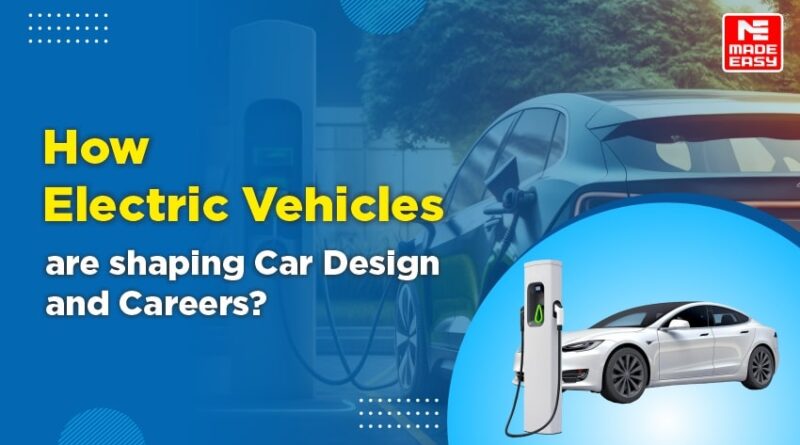How Electric Vehicles are shaping Car Design and Careers?
The modern world is surrounded by a wide range of technologies. If we compare it to previous centuries, we find that emerging technologies have made our lives better, easier, and faster—better in terms of comfort, easier in terms of tackling challenges, and faster in terms of speed. Comparing life in the 1990s with life today reveals a huge difference in lifestyle. This change is reflected in every aspect—be it transportation, entertainment, communication, food, or any other sector. Some of the major reasons for this transformation include easier access to electricity and advancements in the electronics and power sectors.
As we know, every coin has two sides—and this technologically advanced world is no exception. On one hand, it offers convenience and comfort; on the other, it contributes to various environmental problems. However, with the help of technology, these problems can be mitigated to a certain extent. Let’s explore how.
One of the main causes of environmental degradation is the emission of smoke from vehicles. This can be addressed through the use of electric vehicles (EVs). Let’s learn more about EVs.
Table of Contents
EV: The future of transportation
Electric vehicles are one of the most remarkable innovations of humans. But why are they considered so remarkable? This is because nothing new has been designed in the EVs. Only some modifications have been done in the normal vehicles, i.e., just their source of energy has been changed, and a completely different vehicle with better environmental aspects has been shown to the world. Electric vehicles have reduced the dependency on fuels and created a golden era for the technical minds and creative minds to use their talents together, opening the door for new opportunities. Before going further let us look what EVs are actually and how they function.
As the name suggests, Electric Vehicles (EVs) are vehicles that fully or partially rely on electricity as their source of power. EVs include variety of vehicles such as cars, bikes, electric rickshaws, electric boats etc.
Conventional vehicles (which run of fuels like diesel, petrol or CNG) require ignition in order to operate and hence they require an internal combustion engine, whereas EVs have electric motor instead of internal combustion engine and these motors are powered by battery pack.
EVs are quieter, more energy-efficient, and less dependent on fossil fuels. Therefore, they are often referred to as the future of transportation.
History of EV
The birth of Electric Vehicles was not a sudden occurrence. It was a series of events, starting from the use of batteries to electric motors.
In the 1800s, the first EV, the Flocken Electrovagen, was a 4-wheeled, open carriage, 1-horsepower vehicle. It had the maximum speed of 9 miles per hour.
In the late 1800s, these vehicles became popular due to less noise and ease of use. The interests of the urban public towards EVs were seen rising from the 1900s to the 1930s due to many reasons, such as easy access to electricity, easy to drive, quiet operation, etc. However, during the 1930s, the interest reduced due to two main reasons. The first one was the Great Depression of 1929, and the second was advancements in gasoline technology, which led to the development of gasoline-driven vehicles.
During the 20th century, horses/animals were the prime mode of transportation, including steam vehicles, which were the recent invention of that time. However, steam vehicles had some limitations, such as that steam was not very practical for personal vehicles, steam vehicles took more time to start, water needs to be filled at regular intervals, etc., which led to the development of gasoline and electric vehicles. So saying that electric vehicles and gasoline vehicles were the only options for transportation during the 20th century would be incorrect.
However, gasoline vehicles could not attain as much popularity as compared to EVs in the 18th–19th century because of their noisy operation, extra effort required in starting, unpleasant smell, etc., and hence EVs became more popular.
However, the “Model T Car” developed by Henry Ford dealt a huge blow to the EVs in terms of cost. Due to this “Model T Car,” the gasoline vehicles become very affordable and available. Later, the development of electric starters gave rise to the sale of gasoline vehicles, and the sale of EVs started declining.
This phase of electric vehicles continued up to the 1960s. Post-1960s, the rising prices of oil forced the developed nations to restart the R&D on electric and hybrid vehicles. Several private organizations also started indulging in the development of models of electric vehicles. General Motors developed a model of urban electric cars and displayed it at the Environmental Protection Agency’s First Symposium on Low Pollution Power Systems Development in 1973. American Motor Company developed electric delivery jeeps, which were further used by US Postal Services.
But that was not enough; the electric vehicles were way behind the gasoline vehicles in many aspects.
Present State of Electric Vehicles
The actual revival of electric vehicles happened in the late 90s, when Japan released the world’s first hybrid electric vehicles. It became an instant success and helped to raise the profile of the vehicle. The luxury electric sports car by Tesla also helped in building the present image of electric vehicles. In late 2010, Nissan LEAF and Chevy Volt were launched in the market. Volt was the first commercially plug-in hybrid type vehicle, which means it gets switched to gasoline once the battery is depleted, whereas LEAF was all electric vehicles.
With the progress of time, further development took place in the battery technology, which enhanced the vehicle battery performance, reduced the cost, increased the durability of batteries, etc. The current scenario is that EVs are present in every sector of transportation, from rickshaws to cars, from trucks to bikes and cycles. Electric vehicles have covered almost every segment of transportation and are giving tough competition to the gasoline vehicle industry.
Electric Vehicles in India
In a country like India, which aims to achieve net zero carbon emissions by 2070 and about 50% carbon emissions by 2030, electric vehicles play a very important role. Using electric vehicles, carbon emissions can be reduced by up to a significant percent. It would also help us to reduce the dependency on petrol and diesel as fuel, which would be helpful in terms of economy.
To promote the use of EVs among its citizens, the Government of India (GOI) has launched several schemes. Due to this, there has been a significant increase in the manufacturing and sales of electric vehicles in recent years. In recent years, nearly all the major automobile manufacturing companies started investing in electric vehicles, which has increased the range of electric vehicles.
As said earlier, GOI has launched several policies related to EVs, so let us look at some of these policies.
- In 2010, the Ministry of New and Renewable Energy launched an incentive scheme that offered a 20% incentive on the ex-factory prices of EVs. This scheme was withdrawn in March 2012.
- In 2013, the “National Electric Mobility Mission Plan 2020” was launched to boost the adaptation of EVs, address energy security, and reduce vehicular pollution. The majority of this scheme remained unimplemented.
- In 2015, the Faster Adaptation and Manufacturing of Electric Vehicles (FAME) Scheme was announced in the Union Budget with an outlay of ₹ 75 crore to boost clean fuel technology cars, targeting up to 7 million electric vehicles by 2020.
- In 2017, the Indian Transport Ministry aimed for 100% electric cars by 2030, but after industrial concern, this number was brought to 30%.
- In 2019, the Union Government launched FAME II, which was a scheme of ₹ 10,000 crore to accelerate the adaptation of electric vehicles and upgradation of charging infrastructure.
- In 2023, at the 36th GST council meeting, it was decided to reduce the GST rate on electric vehicles from 12% to 5% and from 18% to 5% on charging stations to boost the electric vehicle market.
- In 2024, the Central Government has proposed a new electric vehicle policy, which is under consultation.
Despite all these schemes and efforts, this shift from gasoline vehicles to electric vehicles is not as easy as it looks, especially for countries like India, which are still developing. Let us look at the challenges related to electric vehicles in India.
- Higher cost: Generally, electric vehicles have a high cost in comparison to gasoline vehicles.
- Limited Charging Infrastructure: Charging of EVs is another major aspect that comes to the mind of people before buying electric vehicles. Unlike gasoline vehicles, where petrol pumps are easily available, there are a lesser number of electric vehicle charging stations, even in metro cities. This lack of charging infrastructure creates a fear among the owners of running out of power in the middle of the trip.
- Lack of battery manufacturing system: Batteries play a very important role in electric vehicles. But at the local level, there isn’t any battery manufacturing system; only a few big names come to mind whenever we talk about the battery manufacturing companies. To cater to the demand for batteries, we still rely on other countries, which in turn is visible in our electric vehicle production capacity.
- Dependency on the Grid for Power Supply: The power supply for electric vehicles comes from the electric grid, and India’s electric grid relies heavily on coal-based power plants. Although electric vehicles don’t contribute directly to carbon emissions, indirectly they are also responsible for carbon emissions.
- Climatic conditions: The performance of batteries depends a lot on the climatic conditions. In India, where the temperature in summer crosses above 40-41 degrees, the performance of electric vehicles is significantly affected.
- Lack of skilled manpower: India still lacks the skilled manpower for the maintenance and repair of electric vehicles.
In short, we can say that electric vehicles are still not as famous as gasoline vehicles in India, but there is another aspect of this: the electric vehicle industry is not as competitive as the gasoline vehicle industry. There are a large number of job opportunities in the electric vehicle industry. Let us look at some of them.
Jobs in Electric Vehicles Industry
The electric vehicle industry is new to the market, it is still flourishing and expanding more in comparison to gasoline vehicles. Some of the areas where jobs are possible in the electric vehicle sector are:
- Manufacturing: Manufacturing of EV includes jobs for line workers, engineers, quality checkers, etc.
- Research and Development: The R&D sector focuses on improving various aspects and features of EVs. This includes jobs for software developers, battery engineers, automobile engineers, research scientists, etc.
- Charging infrastructure: Charging infrastructure focuses on improving the charging of EVs. This includes job roles such as project managers, installation technicians, etc.
- Service and Maintenance: Servicing and maintenance are very important for EVs. This sector includes job roles for technicians, supervisors, laborers, etc.
- Supply Chain and Logistics: Supply chain and logistics include various job roles such as supply chain managers, logistics coordinators, procurement specialists, etc.
- Customer support: Customer support includes jobs such as customer support representatives, technical specialists, etc.
These are just a few job roles, the list can go very long. Although the salary and skill depend upon the type of role, experience, and positions. But in this blog, we will look for some technical skills that are required for EV engineers.
Skills required to be an EV Engineer
EV is not a domain-specific technology. It includes the roles of various engineering domains, such as mechanical, electrical, electronics, computer science, automation engineering, etc. Therefore, anyone who wants to have a career in the field of EV must have cross-domain knowledge or engineering skills. The various subject knowledge includes the understanding of technologies like:
- Electric Power Control
- MATLAB, Simulink
- Vehicle Mechanics and Architecture
- Electrical Motor Design
- Battery Engineering and Battery Management system
- Vehicle and System Integration
- Sensing technology
- Image Processing
- Testing and Validation
- Model Based Design
- Hardware Design
- Programming languages
- Embedded C programming etc.
These are just few names, the list can go long depending upon the industry requirements.
Advantages of EV
As said earlier, EVs are the latest trend in transportation, and hence they offer great advantages as compared to the traditional gasoline vehicles. Let us look at some of the advantages offered by the EVs.
- Low Running Cost: Electric vehicles have a low running cost in comparison to traditional gasoline vehicles. This cost can be further reduced if charging is done through renewable resources like solar power, etc.
- Low Maintenance Cost: EVs don’t have as many moving parts as an internal combustion engine. This reduces their yearly maintenance cost in comparison to the traditional gasoline vehicles.
- Low tailpipe emission: As electric vehicles run on electricity, therefore they have very little tailpipe emission, which helps in reducing the carbon footprints. Also, the environmental impact of charging can be reduced by charging using renewable energy options.
- Tax Benefits: Electric vehicles offer great tax benefits. The registration fee and road tax are much lower on the electric vehicles in comparison to the traditional vehicles. Various state governments and central governments launch several schemes to promote the sale of electric vehicles.
- Reducing the dependency on diesel and petrol: We all know how much diesel and petrol pollute our environment, and they are also available in limited quantities. In such a condition, electric vehicles are one of the best alternatives to transportation.
- Ease of operation: EVs are easy to drive and operate. They are quiet in operation, so they reduce the noise pollution. They don’t have gears and thus are convenient to drive.
- Convenience of charging at home: This is one of the biggest benefits of EVs. You can charge electric vehicles at home, unlike the traditional gasoline vehicle, where you have to take the vehicle to the nearest fuel station in order to get it fuelled.
With all these benefits, it can be said that electric vehicles are the future of transportation. Very soon we would see a large number of electric vehicles on the road.
FAQs:
1. What is the future of electric vehicle engineering?
Answer: Electric vehicle engineering offer promising and dynamic career. It is driven by technical advancement, sustainability, growing market demand.
2. Can an electrical engineer become a car designer?
Answer: Generally electrical engineers don’t design cars rather they work on designing and development of electrical systems for cars.
4. Which engineering is best for electric cars?
Answer: There is no specific branch of engineering for electric cars. Manufacturing of electric cars requires interdisciplinary skills.
5. Which engineer designs cars?
Answer: Generally automotive engineers are responsible for the appearance of cars. However, they collaborate with other engineers to improve vehicle’s performance and to enhance the feature of vehicles.
Dear Aspirants,
Your preparation for GATE, ESE, PSUs, and AE/JE is now smarter than ever — thanks to the MADE EASY YouTube channel.
This is not just a channel, but a complete strategy for success, where you get toppers strategies, PYQ–GTQ discussions, current affairs updates, and important job-related information, all delivered by the country’s best teachers and industry experts.
If you also want to stay one step ahead in the race to success, subscribe to MADE EASY on YouTube and stay connected with us on social media.
MADE EASY — where preparation happens with confidence.

MADE EASY is a well-organized institute, complete in all aspects, and provides quality guidance for both written and personality tests. MADE EASY has produced top-ranked students in ESE, GATE, and various public sector exams. The publishing team regularly writes exam-related blogs based on conversations with the faculty, helping students prepare effectively for their exams.




